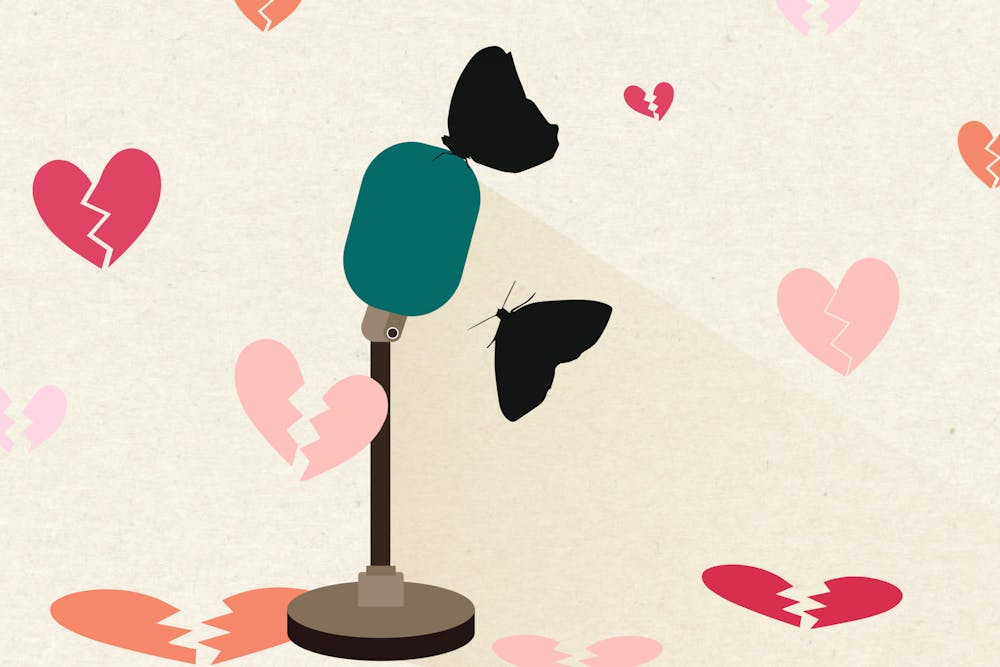As Valentine’s Day approaches, many celebrate the holiday with their lovers or lament in their singledom. Supermarkets fill with heart–shaped chocolates, glittery Hallmark cards, and jumbo teddy bears. But, beyond the pink paraphernalia, Valentine’s Day is also a time to meditate on those we love, have loved, and have lost.
On a Monday night in early February, throngs of eager audience members flooded World Cafe Live to hear five–minute tales of painful or lost love at The Moth StorySLAM—an open–mic storytelling competition held monthly. Anyone is welcome to share, and no previous experience is required.
Jenifer Hixson, a senior director at The Moth, explains how the February theme, aptly titled Love Hurts, was decided upon. She explains, “We like to consider it a sort of Valentine’s Day alternative.” Hixson continues, “It’s a very inclusive theme; not everyone is in a happy relationship, but just about everyone has been through some heartache. Many of the stories take a funny look at the foibles of love because distance from heartbreak gives us the capacity to laugh at ourselves.” She continues, "It’s not all about romantic love, of course. Pets, parents, teachers...a tree! All is fair in love, and love hurts.”
Upon entering, the audience is given slips of paper that read, “Tell us about a time you loved and lost.” Between stories, these slips are read out loud by the host, Caitlin Corkey. These anonymous, short, and often hilarious tales of lost love range between mourning over the end of a long–distance relationship, the death of a beloved herd of chickens, and to someone admitting to losing their virginity on a recent Birthright trip.

Couples, families, and students begin dining on candlelit tables facing a stage drowned with red light. A singular microphone sat in the center of the stage. The room quieted as Caitlin Corkery welcomes the audience. “I brought tissues because I’m fully prepared to cry," Corkey jokes as she shakes up a tote bag filled with the names of potential storytellers. Every Moth show is recorded live, without notes, in front of the audience. After each storyteller leaves the stage, they pull a new name out of the tote bag.
An elderly man is called up and walks on stage with confidence. He clears his throat and begins to recall a lover by the name of “Candy” and her tiny bejeweled dog. He opens with him being handcuffed to Candy’s bed while her tiny dog stares back at him. He states that they both shared a “hatred towards love” that kept them indestructible to heartbreak. He describes Candy pulling out a pregnancy test, fearing that she had been impregnated by her ex–boyfriend. The man recalls the short, tense moment while Candy took the test—he was still handcuffed to his bed. He finishes with remorse, “She was not pregnant, but I regret having to be chained down to be trusted to hear the truth.”
Part of the excitement of being in the Moth audience is the anticipation that comes with each new storyteller. Hixson says her favorite part of her job at The Moth is observing “the volley between the teller and the audience.”

“Up on stage, the teller sketching some scene from their life in full color. In the audience, people see it in their heads and feel it in their hearts. Nothing beats that heart–to–heart transfer.” She continues, “the audience bounces the emotion, or the laughs, back at the teller. The symbiosis is beautiful and so fun to watch.”
Glenn Rice, now a producer at the Moth, describes how his own performance at the Moth persuaded him to become more involved. He says, “I first started attending the Moth almost three years ago, and after seeing a couple live shows at World Cafe, I decided that I wanted to get on stage and tell some stories of my own.” Rice continues, “I’ve told five stories with the Moth since then, mostly dramatic pieces, and about two years ago, I joined the volunteer team as a way to be more involved with the creation of the show.”
After a brief intermission, one woman walks up the stage and the audience quiets as she recalls the first time she laid eyes on a lover—first his arms, then his hair, then his scraggly beard. Every time he walked, she says, his arms swayed by his side. It seemed as if he was always walking towards her.
She then describes the atoms of their bodies intertwining and unwinding. The foreignness of her own body grew in the absence of his. Together we ache at her loss. As she narrates him walking away, both her and the audience reminisce at the love they shared, and mourn the future they never had. As she steps off the stage, the silence breaks and the audience bursts with applause.
Oral storytelling has long been used to bridge the gap between self and others. Aman Goyal, a producer of the Moth show in Philadelphia—and Associate Director of Student Life at Wharton—explains, “Storytelling is how we connect; we are all made up of little stories or vignettes.” Goyal continues, “The reason it’s called The Moth is because moths are drawn to the light just like humans are drawn to stories. It’s a natural instinct to want to listen and tell stories.”
So together, we sit in the darkness, lean into the stories poured out on stage, and drink up the tales of lust, joy, and heartbreak—entranced like moths drawn to light.







